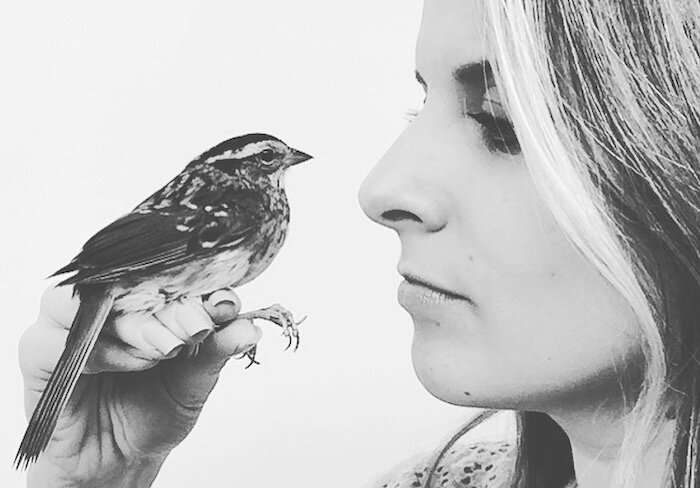Sparrows' storm stress a harbinger of climate-change impact

Sparrows show increased stress when exposed to more numerous and more severe winter storms, says a Western study that tested the songbirds' resilience to the effects of climate change.
And where a canary in a coal mine once provided an early signal of danger to humans below ground, "sparrows in a snowstorm" might be a harbinger of trouble for other species dealing with frequent extreme-weather events, the researchers say.
The paper, recently published in Frontiers in Ecology and Evolution, was co-authored by Ph.D. student Andrea Boyer and Scott MacDougall-Shackleton, director of the Advanced Facility for Avian Research (AFAR) at Western.
Theirs is the first study to simulate, in a controlled setting, the impact of winter storms on birds. "This is one of the few places in the world you can do a study like this," because of the facility's unique capacity to mimic different climate conditions, MacDougall-Shackleton said.
The study showed that white-throated sparrows exposed to one storm a week increased their bodies' energy stores as a survival mechanism; and two storms per week depleted the songbirds' ability to add to, or draw upon, their energy reserves.
The white-throated sparrows' breeding grounds are in boreal forests in Canada's high north and their winter range is as far south as Florida, Boyer said.
The study showed sparrows can 'predict' an impending storm by somehow detecting a drop in barometric pressure—and they will rapidly put on fat and body mass in preparation for it. This creates a metabolic and physiological reserve they can draw upon if a protracted storm leaves them unable to forage for food.
But more frequent storms strain their metabolic and physiological resilience.
In this study, one group of sparrows was exposed to a drop in barometric pressure and a 10-degree drop in temperature (to just above freezing) for eight hours, once a week for nine weeks: a dramatic but realistic simulation of a weekly winter storm.
The once-a-week-storm birds put on body weight and fat to deal with the upcoming windless "storm."
They adapted.
But in a second series of tests on a different group of sparrows, the storms took place twice a week and the birds were not as resilient.
Although they ate more than the control group, they expended that food energy in the moment. They had lower fat stores, less weight gain and therefore lower energy reserves.
"The birds remained healthy in the second study, but they couldn't put on the fat and body mass—they couldn't rely on their 'insurance policy' of extra fat," MacDougall-Shackleton said.
"In the wild, if a bird isn't able to put on that extra storage, they wouldn't be able to recharge and they're at higher risk of starvation," he said.
(In both trials, the birds were fed well during and after the storm.)
Boyer said these birds are naturally quite storm-resilient, so the study results are troubling. "We're throwing these challenges at them and then it becomes a question of whether they can cope, whether they can adapt."
As a sentinel species, the sparrows could also help us understand how other birds and other animals would fare in a world with more severe, more frequent storms.
That's particularly important as massive storms that used to be expected every 20 years are now occurring multiple times in a season.
"A lot of people think about climate change as temperature change and sea levels rising," MacDougall-Shackleton said, "but what many people don't think about as often is the increasing frequency and intensity of storms, which could have an effect on wildlife.
This is the first study to gage birds' responses to storms in a lab with controlled temperature and barometric pressure—a distinct advantage over studies limited to examining how birds in the wild respond to storms.
Boyer has an undergraduate degree in biology/ecology and meteorology and her graduate work combined the two. "I saw the Western (AFAR) wind tunnel and thought this could be used as a weather chamber. It had never been used for that before."
Researchers at AFAR ordinarily study bird reproduction, migration, over-wintering, flight and communication under different environmental conditions but, until now, have not combined that with meteorological work.
Boyer said these birds' responses may also influence biodiversity. "You'll see populations that will, in the future, slowly be declining because they won't be able to handle extreme weather conditions."
More information: Andrea C. Boyer et al. High Rates of Exposure to Simulated Winter Storm Cues Negatively Affect White-Throated Sparrow (Zonotrichia albicollis) Energy Reserves, Frontiers in Ecology and Evolution (2020). DOI: 10.3389/fevo.2020.00222
Provided by University of Western Ontario



















